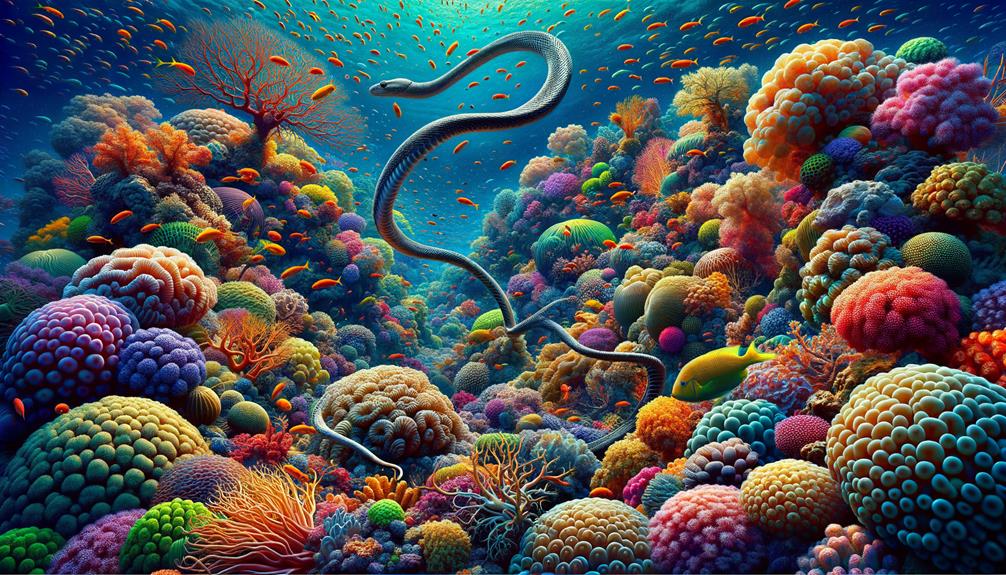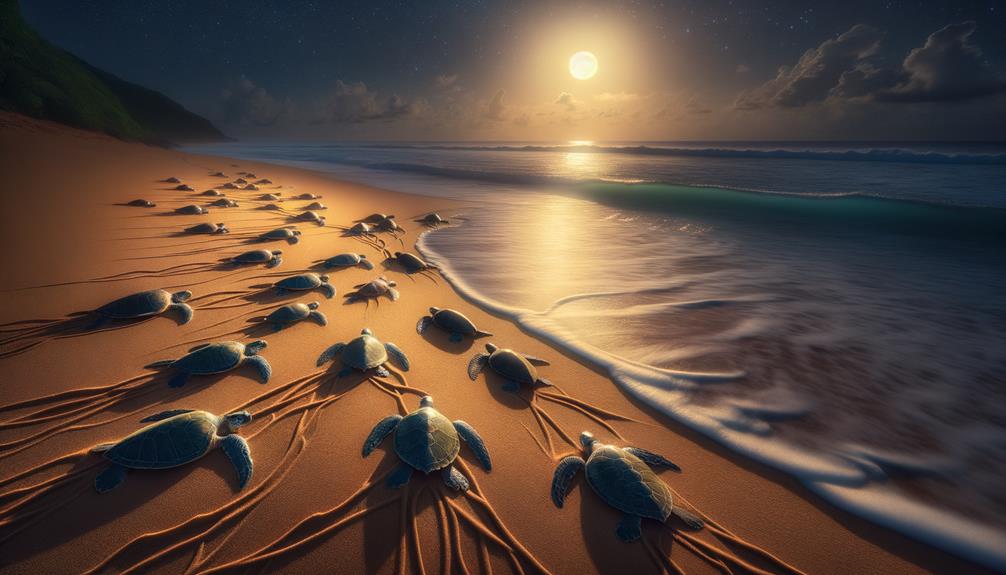Estuarine crocodiles in brackish deltas are fascinating creatures. Their ability to adapt to changing salt levels is remarkable, thanks to specialized glands that help them manage salinity. These ancient reptiles make their homes in a mix of tidal waters, muddy shores, and tangled mangrove forests. As top predators, they're experts at maneuvering through murky waters, using their sharp hunting abilities to keep the local ecosystem in check.
But there's more to these impressive animals than meets the eye. How do they really impact the health of their surroundings? And what can we learn from the way they interact with both their natural habitat and human populations nearby?
These questions open up a world of possibilities for research and understanding. By studying estuarine crocodiles, we might uncover new insights into coastal ecosystem management or even find inspiration for tackling environmental challenges. Their resilience in the face of changing conditions could offer valuable lessons as we grapple with global climate shifts.
So next time you hear about these powerful reptiles, remember: they're not just fearsome predators, but also key players in a complex and vital ecosystem. Their story is one of survival, adaptation, and the delicate balance of nature.
Adaptability to Environments
Estuarine crocodiles thrive in brackish deltas where fresh and seawater mix, creating a rich habitat. These areas, with their changing salt levels, offer these crocs – also called saltwater crocodiles – varied hunting spots full of fish, crabs, and other water creatures.
Their success in these waters comes down to special body features. They've developed salt glands that help balance salt in their bodies. This lets them live where other animals might struggle. Their ability to handle salt shows how tough they are and how well they adapt to changing conditions.
These ever-changing ecosystems push the crocs to their limits, ensuring only the most adaptable survive. The constant mix of fresh and salt water makes for a challenging yet rewarding home. For these crocodiles, brackish deltas aren't just where they live – they're proof of how well they've evolved to make the most of the varied hunting grounds and plentiful food sources available.
Habitat Characteristics
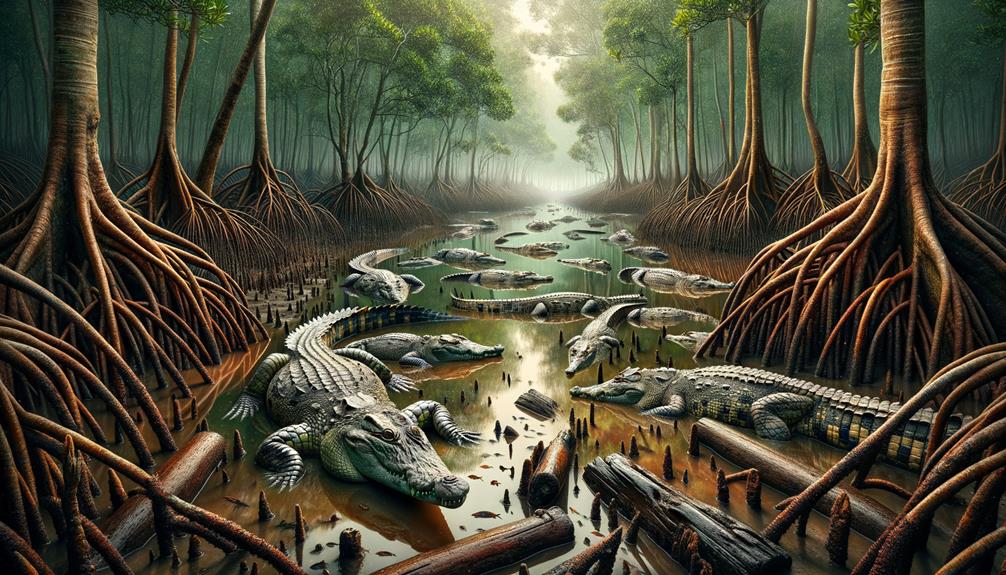
At the meeting point of rivers and seas, brackish deltas create a lively mix of tides, mudflats, and mangrove forests. These areas offer estuarine crocodiles the perfect blend of fresh and salt water to call home. The constant push and pull of tides shape the landscape, forming mudflats rich with potential meals and key hunting spots for these top predators.
Mangrove forests provide safe havens and breeding grounds, with their complex root systems giving crocodiles places to nest and reproduce. The mix of water types supports a wide range of creatures, ensuring these powerful reptiles always have food on the menu. Estuarine crocodiles play a key role in these ecosystems, keeping prey numbers in check and shaping their environment.
The unique combo of salty water and thick plant life in brackish deltas suits the crocodiles' hunting style and nesting needs perfectly. By thriving in these rich, in-between zones, estuarine crocodiles help maintain the delicate balance of their surroundings. They're living proof of nature's toughest survivors, able to adapt and flourish in challenging conditions.
Hunting Strategies
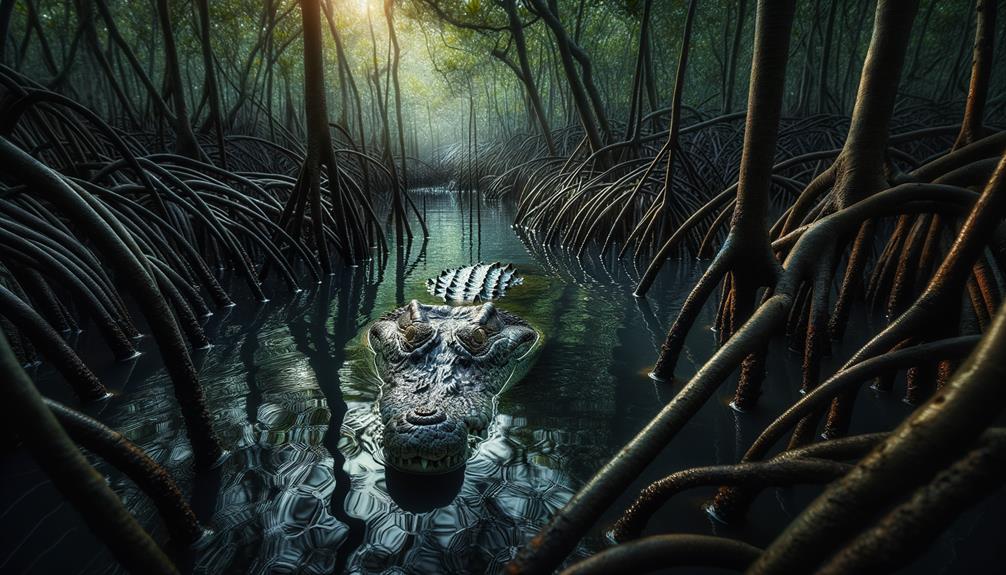
Estuarine crocodiles are masters of stealth hunting. They hang out just below the water, eyes and nostrils barely visible, ready to snap at any unsuspecting prey that wanders too close. These big lizards are nature's perfect predators, blending in so well with their surroundings that you'd never see them coming.
These crocs don't mess around when it comes to catching dinner. They'll wait for ages, still as statues, until the right moment strikes. Then, bam! Those massive jaws clamp down with ridiculous force, and it's game over for whatever poor creature they've targeted.
The fact that these reptiles thrive in brackish waters gives them a serious edge. These spots where rivers meet the sea are teeming with all sorts of potential meals. The murky waters and thick vegetation in these areas are like a crocodile's dream come true, letting them sneak up on their prey without breaking a sweat.
It's this combo of patience, power, and perfect camouflage that makes estuarine crocodiles the top dogs – or should we say top crocs – in their watery world. They've got the whole ambush thing down to a science, and it shows in how well they dominate their ecosystem.
Reproductive Behavior
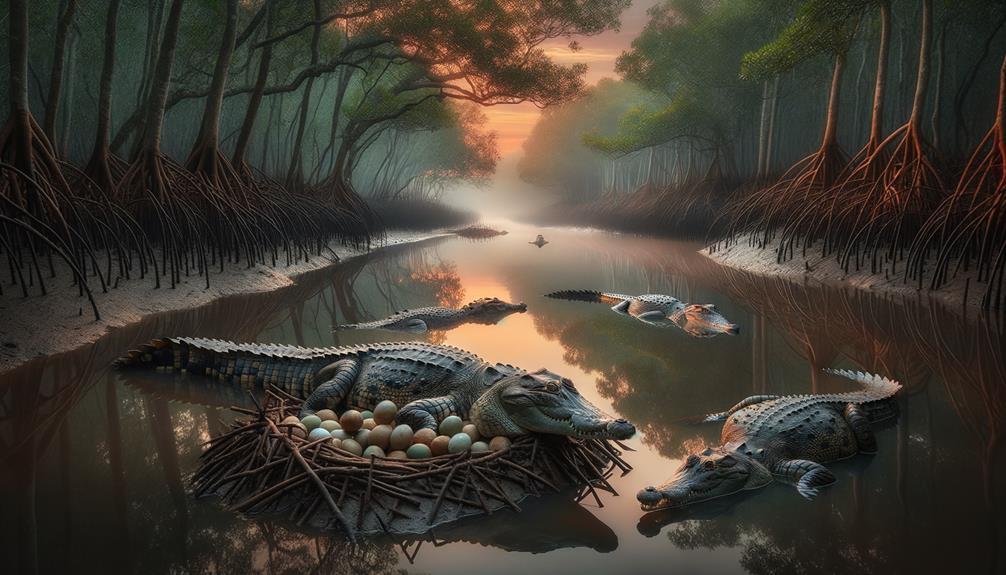
Estuarine crocodiles aren't just fierce hunters; their breeding habits are equally captivating. Female crocs are picky about their nesting spots, often choosing sandy areas near tidal rivers or freshwater during the wet season. They dig holes and lay 40 to 60 eggs, covering them with sand or plants to protect against predators and environmental risks.
The temperature around the eggs actually determines whether the babies will be male or female. Once hatched, mom crocs become incredibly protective. They guard their nests fiercely until the young disperse, typically at about 8 months old. Despite this care, only about 1% of hatchlings make it to adulthood due to predators and habitat challenges.
What stands out about these reptiles' breeding habits?
- Their careful selection and preparation of nesting sites
- The intense protection mothers provide for their nests
- The slim odds of survival for young crocodiles
- How temperature shapes the gender of the offspring
These behaviors showcase the remarkable tenacity and commitment of estuarine crocodiles in perpetuating their species.
Ecological Importance
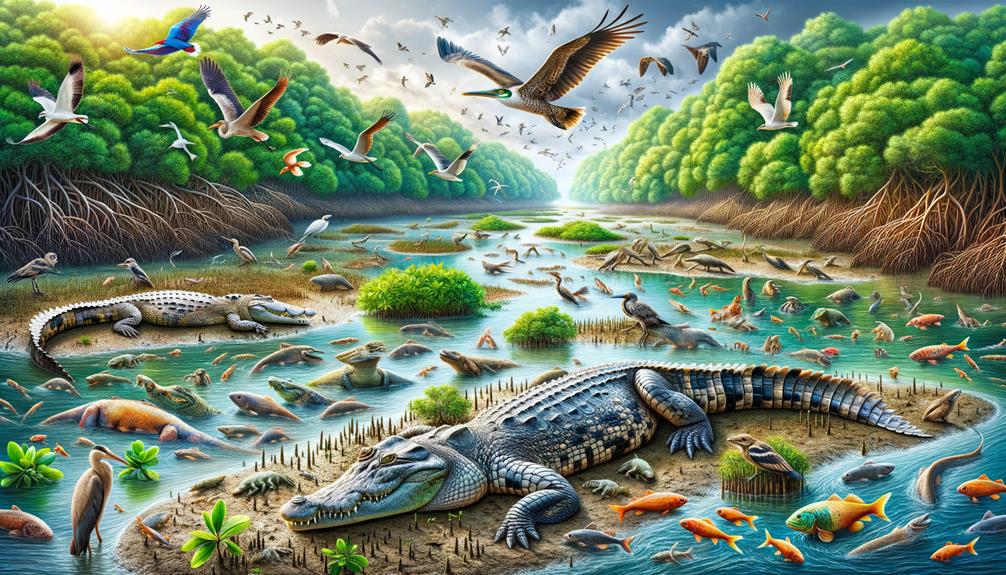
In the murky waters of brackish deltas, estuarine crocodiles play a vital role in keeping the ecosystem in check. These top predators help maintain a delicate balance by controlling fish and invertebrate populations. Their hunting habits prevent any single species from taking over, which in turn promotes biodiversity throughout the delta.
The impact of these crocodiles extends beyond just population control. When they eat and digest their prey, they spread nutrients through their waste, enriching both water and soil. This process supports plant growth and helps other delta species thrive.
The presence of estuarine crocodiles creates a domino effect in the ecosystem. Their interactions with other creatures contribute to a complex, ever-changing environment where each organism has a part to play in maintaining equilibrium.
Scientists and conservationists emphasize that these crocodiles are key to the health and longevity of brackish deltas. Their role highlights the interconnectedness of species within these unique habitats and underscores the need for their protection.
Understanding the ecological significance of estuarine crocodiles helps us appreciate the intricate web of life in delta ecosystems. It also reminds us of the importance of preserving these habitats and the species that call them home.
Human Interactions
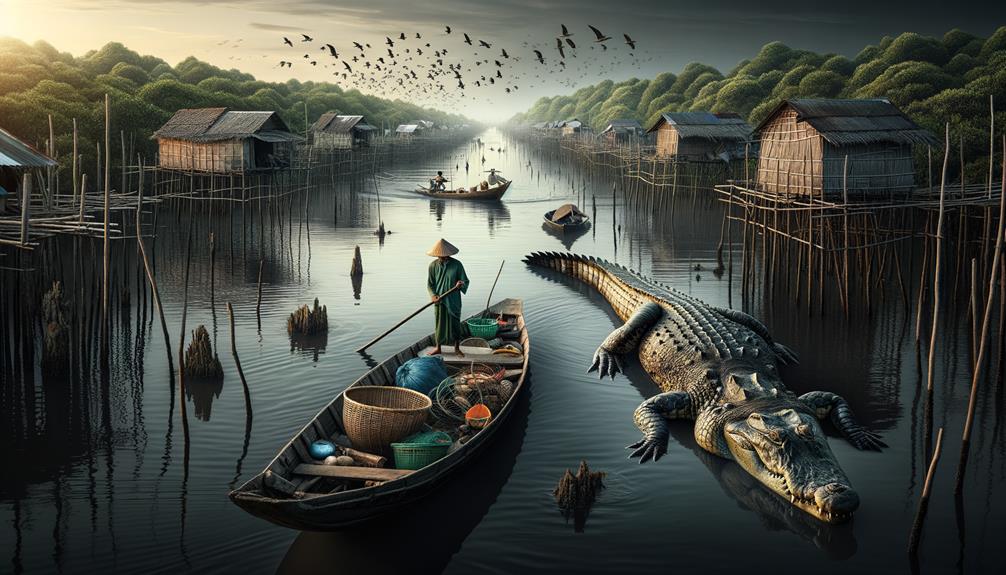
People living near brackish deltas often clash with estuarine crocodiles due to shared spaces and human expansion into croc territory. This overlap puts local residents and fisherfolk at risk. Fishing and farming unintentionally draw these powerful predators, ramping up the chances of dangerous encounters.
These run-ins have serious fallout for both sides. Locals live on edge, with real threats to their safety and income. Some resort to illegally killing crocs, which hurts their population numbers.
The situation breeds:
- Constant worry among residents
- Money troubles when fishing's disrupted
- Potential for harm or death
- Fewer crocs, throwing off nature's balance
Tackling these problems means striking a balance between what people need and protecting wildlife. Teaching locals how to coexist with crocs can help reduce clashes. By grasping how habitats overlap, we can find ways to keep both people and estuarine crocodiles safe in these delta areas.
Conservation Efforts
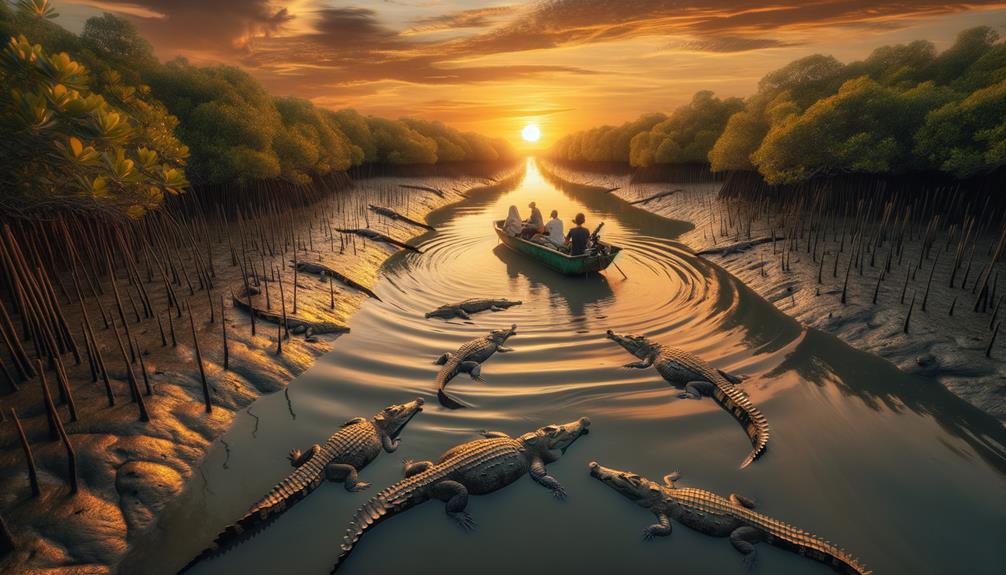
Estuarine crocodile conservation in brackish deltas hinges on two key pillars: habitat restoration and anti-poaching measures. Bringing these ecosystems back to health tackles pollution and habitat destruction, safeguarding these vital environments. Meanwhile, robust efforts to curb illegal hunting play a crucial role in protecting crocodile populations from undue pressures. These twin approaches form the backbone of current preservation strategies, ensuring these ancient reptiles continue to thrive in their natural habitats. Restoring polluted waters and degraded shorelines gives these creatures the space they need, while cracking down on poachers helps maintain stable population numbers. It's a balancing act, but one that's showing promising results in many regions where these impressive animals make their home.
Habitat Restoration Projects
Restoring estuarine crocodile habitats in brackish deltas is all about making their nesting and feeding spots better. This helps boost the variety of life in these areas and makes the whole system more resilient. We're planting local plants and getting rid of invaders to make these places more welcoming for these impressive reptiles. A big part of this work is setting up safe spots for crocs to lay eggs, away from people.
Fixing up these habitats doesn't just help the crocodiles. It makes the whole area thrive with more plants and animals, which in turn gives the crocs more to eat.
We're seeing some real wins:
- More crocs around, which is great news for their future
- More baby crocs making it to adulthood, which gives us hope
- Fewer run-ins between people and crocs, as the animals have their own space
- A comeback for local plants and animals, which is amazing to see
This work shows we're serious about keeping estuarine crocodiles around and making sure they can live in peace in the brackish deltas.
Anti-Poaching Initiatives
Keeping watch over waterways and swamps is key to stopping illegal hunting of saltwater crocs in river deltas. Our work relies on constant surveillance to catch wrongdoers and protect these impressive reptiles. We've teamed up with local cops and wildlife officers to beef up our efforts, making sure hunting laws are strictly followed.
High-tech gear like GPS trackers and hidden cameras are game-changers for us. These gadgets help us collect vital info on poaching and croc movements. Understanding their habits lets us stay one step ahead of the bad guys.
Getting locals involved is another big part of our plan. By working with nearby communities, we've built a network of watchful neighbors who report fishy business and spread the word about why these crocs matter. Teaching folks about these scaly residents helps them feel responsible for protecting them.
Our mix of boots-on-the-ground enforcement, community teamwork, and fancy tech has really put a dent in poaching. If we keep at it, saltwater crocs will keep ruling their muddy kingdom, safe from hunters' crosshairs.
Frequently Asked Questions
Do Crocodiles Live in Brackish Water?
Crocodiles definitely make their home in brackish water. These tough reptiles are incredibly adaptable, flourishing in environments where fresh and salt water mix. Their presence plays a key role in keeping local ecosystems in check. They help control the numbers of other animals and contribute to the movement of nutrients, which is vital for maintaining the health of these unique habitats.
Do Crocodiles Live in Deltas?
Crocodiles thrive in delta regions. These areas provide a smorgasbord of food, prime spots for nesting, and a unique blend of salty and fresh waters. It's no wonder these ancient reptiles have made deltas their home. The mix of water types creates a rich ecosystem that supports a variety of prey, giving crocs plenty of dining options. When it's time to lay eggs, the soft banks and secluded spots offer safe havens for their young. These apex predators have found their sweet spot in these complex waterways, adapting perfectly to life where rivers meet the sea.
Are Estuarine Crocodiles the Same as Saltwater Crocodiles?
Estuarine crocodiles and saltwater crocodiles are actually the same species, perfectly at home in coastal waters. These impressive reptiles have adapted to thrive in both fresh and salty environments, making them key players in their ecosystems. Much like skilled sailors navigating challenging waters, these crocs have mastered life in the dynamic conditions where rivers meet the sea.
Where Does the Estuarine Crocodile Live?
Estuarine crocodiles make their home across a vast stretch of the world, from the coastal regions of India all the way to the remote islands of Micronesia. These impressive reptiles have a knack for living in mixed-salinity environments, particularly favoring spots where rivers meet the sea. You'll often spot them in tidal estuaries, among dense mangrove forests, and along shorelines.
What's fascinating about these crocs is their remarkable ability to switch between salt and fresh water with ease. This unique adaptation allows them to thrive in a variety of aquatic settings. River deltas and tidal waterways offer prime real estate for these adaptable creatures, providing them with an ideal mix of conditions to hunt, breed, and bask.


